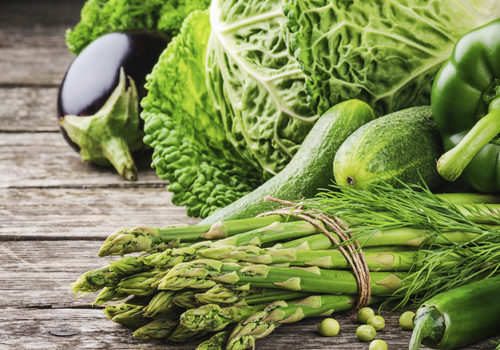
The U.S. government recommends that men and women between the ages of 31 and 50 get two and a half to three cups of vegetables a day, a goal that many nationwide are failing to meet. The nutrient content of vegetables provides a variety of benefits, from maintaining immune health to potentially lowering the risk of stroke and certain cancers (1). If you want to reach the vital recommended daily amount of veggies or simply want to increase vegetable content in your diet, there’s an option that may be flying under your radar: green superfoods. These powdered mixtures of healthy greens boast the nutritional content of the healthiest vegetables available, all in a simple, versatile package.
Making the Superfood Super
As both interest and research grow in regards to green superfoods, so do the amount of offerings, making it daunting for someone trying these powders out for the first time. Despite the volume of choices, all green superfoods contain some or all of the following components (2):
Grasses. The base of most green superfood powders consists of various cereal grasses, including wheat, barley, oat, alfalfa and dandelion. These grasses are linked to many health functions, such as wheat grass supporting the liver and digestive system, alfalfa serving as a deterrent to fungus and barley grass providing heavy amounts of nutrients like calcium and iron. When serving as the base to a superfood powder, cereal grasses are generally accompanied by lecithin and beta-glucans.
Digestive enzymes. These enzymes serve a dual purpose: aiding those with sensitive digestion while helping the body absorb as many nutrients as possible from the powder.
Sea vegetables/algae. Sea vegetables like dulse and kelp contain valuable minerals like iodine, iron and phosphorous. They also can help with excreting bad cholesterol and digestive support. Research is ongoing to investigate potential antibiotic and anti-aging properties (4).
Spirulina and chlorella are two of the most common algae seen in superfood powders. These and other algae are the best sources available for chlorophyll, and can aid in inflammation relief and cell renewal. In addition, they contain a wealth of nutrients and support healthy energy, the immune system and more (5).
Greens. One of the most important components of a superfood powder, popular greens include spinach, kale, bok choy and parsley. These specific greens are chosen due to their high nutritional content.
Many other healthy ingredients are often included in superfood powders, including probiotics, herbs, fibers, fruits and more. This variety means that you have plenty of choices when it comes to finding the supplement that suits your health needs.
Picking Your Superfood
With all these options, it’s easy to get lost when choosing your superfood powder. The best way is finding your own perfect balance between nutrition and taste. On the nutritional end, it pays to read the labels. While all the options on the market boast high nutritional content, how they accomplish that varies, so it’s important to know what combination of ingredients is being used, especially since ingredient density often correlates with price.
Taste is a bit more subjective, but also more important than you many think. After all, if you’re not happy with the taste of something you should be taking daily, it makes it that much easier to fall off the wagon—especially for those trying green superfoods for the first time.
Some people love the earthy taste of greens, but if you’re looking for superfood powders without this strong taste, look for those with natural sweeteners, such as berries, raw honey, stevia or agave nectar (7). Another option for first-timers is starting off with a smaller portion, especially with higher-potency blends (8). In time, you can work your way up to a full serving.
Making it Tasty
While the traditional method of consuming green superfood powders is mixing it with water, there are other options. One common alternative is mixing the powder with your favorite fruit or vegetable juice, masking the taste of some of the stronger blends. Smoothies are also a popular option for this same reason. For those looking beyond drinks, sprinkling the powder over yogurt is another great way to incorporate superfoods into a healthy snack. Should one be looking for more exciting options, these powders can also be incorporated into various recipes. One green superfood powder retailer has recipes on its Web site from salad dressing to pancakes, all using superfood powders as an ingredient. Superfoods for dessert? This is another possibility, as recipes for brownies and sorbets also exist (6). WF
References
1. U.S. Department of Agriculture, Choosemyplate, www.choosemyplate.gov/food-groups/vegetables-why.html, accessed June 30, 2014.
2. HealthKismet, “The Unofficial Superfood Powder Buying Guide,” blog.healthkismet.com/green-superfood-powder-buying-guide, accessed June 30, 2014.
3. BodyEcology, “Barley Grass, Alfalfa and the Other Healthiest Grasses You Should Incorporate Into Your Diet,” http://bodyecology.com/articles/healthiest_grasses.php#.U7GtKnJdWm4, accessed June 30, 2014.
4. Chatelaine, “Health Benefits of Seaweed and Sea Vegetables,” www.chatelaine.com/health/diet/health-benefits-of-seaweed-and-sea-vegetables, accessed June 30, 2014.
5. Alive.com, Spirulina and Chlorella, www.alive.com/articles/view/
22237/spirulina_chlorella, accessed June 30, 2014.
6. Allbasic, “Recipes,” www.allbasic.eu/recipes/, accessed July 1, 2014.
7. GreensPowder, “Choosing the One That’s Right for You,” www.greenspowder.net/greens-powder-choosing-the-one-thats-right-for-you/, accessed July 1, 2014.
8. Superfood Drinks.org, “A Guide to Buying Green Drinks,” http://superfooddrinks.org/a-guide-to-buying-green-drinks/, accessed July 1, 2014.
Published in WholeFoods Magazine, September 2014










